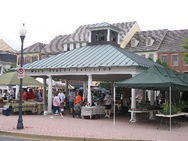Dear Andres Duany: Money, not millennials, hurting cities
Dear Mr. Duany,
At twenty-two years old, I qualify as a Millennial. I enjoy loud music and cheap, greasy food, among other things. I also love cities, including Washington, D.C., the one I was born in. I can’t afford to live there, so I live at home with my parents. Yet, according to what you recently told the Atlantic, I’m ruining the place:
“There’s this generation who grew up in the suburbs, for whom the suburbs have no magic. The mall has no magic. They’re the ones that have discovered the city. Problem is, they’re also destroying the city. The teenagers and young people in Miami come in from the suburbs to the few town centers we have, and they come in like locusts …
They have this techno music, and the food cheapens, and they run in packs, great social packs, and they take over a place and ruin it and go somewhere else.”
But you know what really kills a city? Keeping people out. Making it prohibitively expensive by demanding it look or feel a certain way. A city cannot be planned all at once or dropped from the sky. A city is the accumulation of years and years of small changes made by many, many people of all kinds, creating a unique, irreplacable product.
I don’t think you understand that — which is understandable, because it took me a while to figure it out.
When I was eleven, my family moved from an apartment in a then-declining Silver Spring, an inner suburb of D.C., to that archetypal split-level house on a cul-de-sac many miles away.
I was chagrined to find that there just wasn’t much to do out here. I was a skinny, brainy child who had no discernible social skills but loved drawing and architecture, and I was terribly bored in my new home. But while my friends dove into music or sports or science fiction, I found you, in the pages of a magazine in my local grocery store advertising “America’s New Traditional Neighborhoods.”
There was a place, the article said, just a half-hour from my house called Kentlands, where a kid my age could go to see friends, to go fishing in a lake, and to see a movie without his parents driving him or worrying that he’d get mugged on the street. He could just ride his bike there. I was immediately hooked.
After I first read about Kentlands, I learned why it worked. Shops and schools were within walking distance. A grid of narrow streets dispersed traffic. Homes were closer together, but more importantly, there were different kinds of homes closer together, in different price ranges, so ideally anyone could live there. It was basically the neighborhood our family had given up on, but new. In high school, I’d finally go to Kentlands and interview a resident for a class project and at fifteen, it felt like meeting a celebrity.
I’m twenty-two now, and I’ve been to Kentlands many times since. But I’ve been to architecture school, and I’ve learned about Rome and Paris, and visited New York and San Francisco. At least twice a week I go into downtown Washington, D.C. and I eat and drink and have fun with my friends. Afterwards, we go home to Maryland and Virginia, often to our parents’ houses where we still live because, I’d learn, we couldn’t afford much else.
A lot of things helped Washington emerge from decades of urban decay, but I would argue Kentlands is one of them. Like you say, my generation loves the city - and it’s because we learned to while hanging out in Kentlands’ Market Square on a Friday night. Or, in my case, going to one of the many town centers that sprouted up across Montgomery County and the D.C. area, whether directly or indirectly inspired by Kentlands.
Those of us who spent our teenage years in the new downtowns of Bethesda or Silver Spring now go to Dupont Circle or Georgetown. We’re helping to revitalize other parts of the city, like H Street and Petworth, that have suffered from disinvestment. Not only are these neighborhoods coming back to life, but they’re quickly becoming too sought-after for me to live in. Even downtown Silver Spring, my old neighborhood, is out of my reach.
I know now that a city isn’t just about riding your bike to the movies. But that’s all Kentlands can provide. It never fulfilled its promise to become a diverse community. Despite having everything from one-room granny flats to million-dollar mansions, it’s still a homogeneous, affluent, predominantly white place. And now, twenty years later, much of D.C. is starting to look like Kentlands.
When I was so anxious to find the world that lay beyond my cul-de-sac, you showed me how to find it. I do love my city desperately, and one day when I have the means I’d love to move there and invest and contribute to it. Yet according to you, I don’t deserve to.

